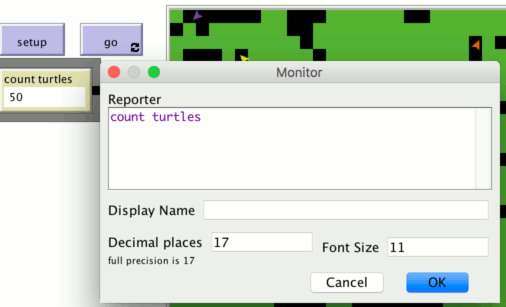

If the floating parameter is not set or false, each patch is related to a logical JAM node. In a patch grid the world is divided into patches. This is a classical simulation world derived from the NetLogo simulation world model used for simulating social and technical systems. $nodeclass : function (x:number,y:number) -> simobjĭefines a one, two, or three-dimensional meshgrid network of nodes connecting neighbouring nodes. Some custom node constructor functions

Create some custom nodes dynamically with a constructor functon Connections between nodes (with virtual port conectors)Ĭonnect? : function (node1,node2,port1,port2) -> boolean,

The simulation model is defined by a JS object structure containing the following sections: model type model = , Nodes (except in mesh- and patch grid worlds) can be moved within the two-dimensional world carrying their agents. Migration of computational agents (default) and propagation of message signals still require explicit links between nodes.Ĭommunication ports and links have either (static or dynamic) point-to-point or broad/multicast characteristics, i.e., nodes within a specific spatial range can communicate with each other (computational agents). A patch grid arranges nodes in a two-dimensional grid, too, but with an implicit global virtual communication link that enables migration of phyiscal agents between any of the nodes in the grid. The default agent type is computational and agents represent mobile software.Ī meshgrid network arranges nodes in a two-dimensional grid (that can be irregular and incomplete).Ī patchgrid network is similar to NetLogo simulation worlds. The latter represent physical entities like, e.g., humans, ants, cars. There are computational and physical agents. Nodes are placed in a two-dimensional spatial simulation world, and each node has a distinct position.
#Netlogo icon movie#
Generated models can be exported locally, turned into a movie or saved as applets and used in the educational process, while the integrated API enables developers to integrate NetLogo into their projects.A simulation world consists of agent processing nodes (logical/virtual JAM nodes) and some communication links between nodes enabling migration of agents and propagation of signals between nodes. NetLogo can run simulations for various phenomena, providing 3D modeling tools and multiple visualization options. Its syntax is not difficult, but it might take a while to get familiar to all the functions. It uses a variation of the Logo educational programming language, modified to support both mobile and stationary agent monitors, called turtles and patches, respectively.
#Netlogo icon code#
While you mostly work with graphical elements to create your model, NetLogo automatically generates the corresponding source code in the background.
#Netlogo icon full#
Furthermore, you can enter a full description of the model and describe how it works, what elements should the user notice and what parameters should be modified to observe changes. You can use buttons, sliders, switches, input boxes, choosers, monitoring panes, plots and text note areas to write down your conclusions. You have multiple elements at your disposal for building a new environment. For instance, climate change hinges on factors such as the sun brightness, cloud presence, the CO2 amount or the albedo (reflection coefficient). The provided samples include models from various fields, such as art, biology, chemistry, physics, Earth science, math, social sciences, as well as curricular models developed by The Center for Connected Learning and Computer-Based Modeling.Įach model you load or create simulates situations that depend on one or multiple variables, which you can adjust to view the results. The application features a rich and diverse model library that can offer a starting point in creating your own simulation. It targets complex and dynamic situations that change over time, enabling the user to study social behavior, find patterns and explanations. NetLogo is a cross-platform application designed to simulate social or natural events of all kinds.


 0 kommentar(er)
0 kommentar(er)
